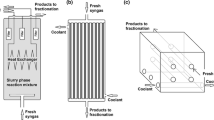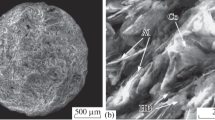Abstract
This work aims to evaluate formed products according to the Anderson-Schulz- Flory (ASF) distribution in Fischer-Tropsch synthesis. The crystalline phases of cerium and cobalt were confirmed in the mesoporous structure of the SBA-15 molecular sieve. The ASF distribution model showed a distribution of products with two chain growth probabilities, α1 and α2 for Co/Ce/SBA-15 catalyst. The maximum production of hydrocarbons was in the range of light olefins, followed by gasoline.
Graphical Abstract










Similar content being viewed by others
References
Bezemer GL, Bitter JH, Kuipers HPCE et al (2006) Cobalt particle size effects in the Fischer–Tropsch reaction studied with carbon nanofiber supported catalysts. Am Chem Soc 128(12):3956–3964
Vo D-VN, Arcotumapathy V, Abdullah B et al (2013) Evaluation of Ba-promoted Mo carbide catalyst for Fischer–Tropsch synthesis. J Chem Technol Biotechnol 88(7):1358–1363
Dry ME (2001) High quality diesel via the Fischer–Tropsch process—a review. J Chem Technol Biotechnol 77(1):43–50
Griboval-Constant A, Butel A, Ordomskya VV et al (2014) Cobalt and iron species in alumina supported bimetallic catalysts for Fischer–Tropsch reaction. Appl Catal A 481:116–126
Dai X, Yu C, Li R (2007) Deactivation of CeO2-promoted Co/SiO2 Fischer–Tropsch catalysts. Chin J Catal 28(12):1047–1052
Bartolini M, Molina J, Alvarez J et al (2015) Effect of the porous structure of the support on hydrocarbon distribution in the Fischer–Tropsch reaction. J Power Sources 285:1–11
Huang J, Qian W, Zhang H et al (2018) Influences of ordered mesoporous silica on product distribution over Nb-promoted cobalt catalyst for Fischer–Tropsch synthesis. Fuel 216:843–851
González GP, Martínez A, Murciano R et al (2009) Cobalt supported on morphologically tailored SBA-15 mesostructures: the impact of pore length on metal dispersion and catalytic activity in the Fischer–Tropsch synthesis. Appl Catal A 367(1–2):146–156
Pardo-Tarifa F, Cabrera S, Sanchez-Dominguez M et al (2017) Ce-promoted Co/Al2O3 catalysts for Fischer–Tropsch synthesis. Int J Hydrogen Energy 42(10):9754–9765
Dai X, Yu C, Li R et al (2006) Role of CeO2 promoter in Co/SiO2 catalyst for Fischer–Tropsch synthesis. Chin J Catal 27(10):904–910
He L, Teng B, Zhang Y et al (2015) Development of composited rare-earth promoted cobalt-based Fischer–Tropsch synthesis catalysts with high activity and selectivity. Appl Catal A 505:276–283
Zhang X, Su H, Zhang Y et al (2016) Effect of CeO2 promotion on the catalytic performance of Co/ZrO2 catalysts for Fischer–Tropsch synthesis. Fuel 184:162–168
Johnson GR, Bell AT (2016) Effects of Lewis acidity of metal oxide promoters on the activity and selectivity of Co-based Fischer–Tropsch synthesis catalysts. J Catal 338:250–264
Yang R, Zhou L, Gao J et al (2017) Effects of experimental operations on the Fischer–Tropsch product distribution. Catal Today 298:77–88
Puskas I, Hurlbut RS (2003) Comments about the causes of deviations from the Anderson–Schulz–Flory distribution of the Fischer–Tropsch reaction products. Catal Today 84(1–2):99–109
Cheng J, Song T, Hu P et al (2008) A density functional theory study of the α-olefin selectivity in Fischer–Tropsch synthesis. J Catal 255(1):20–28
Madon RJ, Iglesia E (1993) The importance of olefin readsorption and H2/CO reactant ratio for hydrocarbon chain growth on ruthenium catalysts. J Catal 139(2):576–590
Zhao D, Feng J, Hou Q et al (1998) Triblock copolymer syntheses of mesoporous silica with periodic 50 to 300 Angstrom pores. Science 279(5350):548–552
Zhao D, Hou Q, Feng J et al (1998) Nonionic triblock and star diblock copolymer and oligomeric surfactant syntheses of highly ordered, hydrothermally stable, mesoporous silica structures. JACS 120(24):6024–6036
González GP, Concepción P, Murciano R al (2013) The impact of pre-reduction thermal history on the metal surface topology and site-catalytic activity of Co/SiO2 Fischer–Tropsch catalysts. J Catal 302:37–48
Blasco T, Botella P, Concepción P et al (2004) Selective oxidation of propane to acrylic acid on K-doped MoVSbO catalysts: catalyst characterization and catalytic performance. J Catal 228(2):362–373
Martínez A, González GP, Rollán J (2009) Nanofibrous γ-Al2O3 as support for Co-based Fischer–Tropsch catalysts: pondering the relevance of diffusional and dispersion effects on catalytic performance. J Catal 263(2):292–305
González GP (2010) Requerimientos físico-químicos y estructurales en catalizadores avanzados para la conversión de gas de síntesis. Polytechnic University of Valencia, Valencia
Sousa BV (2009) Desenvolvimento de catalisadores (Co/MCM-41) destinados a reação de Fischer–Tropsch. Federal Universitiy of Campina Grande, Campina Grande
Sing KSW (1985) Reporting physisorption data for gas/solid systems with special reference to the determination of surface area and porosity. Pure Appl Chem 57(4):603–619
Borg O, Eri S, Blekkan EA et al (2007) Fischer–Tropsch synthesis over γ-alumina-supported cobalt catalysts: effect of support variables. J Catal 248(1):89–100
Acknowledgements
This research was supported with a partnership between Department of Chemical Engineering - Federal University of Campina Grande and Higher Council for Scientific Research - Polytechnic University of Valencia. The scholarship was awarded by Coordination for the Improvement of Higher Level Education a Personnel (CAPES).
Author information
Authors and Affiliations
Corresponding author
Ethics declarations
Conflict of interest
The authors declare that they have no conflict of interest.
Additional information
Publisher’s Note
Springer Nature remains neutral with regard to jurisdictional claims in published maps and institutional affiliations.
Rights and permissions
About this article
Cite this article
Albuquerque, J.S., Costa, F.O. & Barbosa, B.V.S. Fischer–Tropsch Synthesis: Analysis of Products by Anderson–Schulz–Flory Distribution Using Promoted Cobalt Catalyst. Catal Lett 149, 831–839 (2019). https://doi.org/10.1007/s10562-019-02655-4
Received:
Accepted:
Published:
Issue Date:
DOI: https://doi.org/10.1007/s10562-019-02655-4




